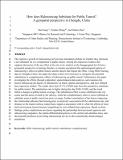How does ridesourcing substitute for public transit? A geospatial perspective in Chengdu, China
Author(s)
Zhang, Xiaohu; Zhao, Jinhua
DownloadAccepted version (5.097Mb)
Publisher with Creative Commons License
Publisher with Creative Commons License
Creative Commons Attribution
Terms of use
Metadata
Show full item recordAbstract
The explosive growth of ridesourcing services has stimulated a debate on whether they represent a net substitute for or a complement to public transit. Among the empirical evidence that supports discussion of the net effect at the city level, analysis at the disaggregated level from a geospatial perspective is lacking. Besides, it remains unexplored the spatiotemporal pattern of ridesourcing's effect on public transit, and the factors that impact the effect. Using DiDi Chuxing data in Chengdu, China, this paper develops a three-level structure to recognize the potential substitution or complementary effects of ridesourcing on public transit. Furthermore, this paper investigates the effects through exploratory spatiotemporal data analysis, and examines the factors influencing the degree of substitution via linear, spatial autoregressive, and zero-inflated beta regression models. The results show that 33.1% of DiDi trips have the potential to substitute for public transit. The substitution rate is higher during the day (8:00–18:00), and the trend follows changes in public transit coverage. The substitution effect is more exhibited in the city center and the areas covered by the subway, while the complementary effect is more exhibited in suburban areas as public transit has poor coverage. Further examination of the factors impacting the relationship indicates that housing price is positively associated with the substitution rate, and distance to the nearest subway station has a negative association with it, while the effects of most built environment factors become insignificant in zero-inflated beta regression. Based on these findings, policy implications are drawn regarding the partnership between transit agencies and ridesourcing companies, the spatial-differentiated policies in the central and suburban areas, and the potential problems in providing ridesourcing service to the economically disadvantaged population.
Date issued
2020-06Department
Massachusetts Institute of Technology. Department of Urban Studies and PlanningJournal
Journal of Transport Geography
Publisher
Elsevier BV
Citation
Kong, Hui, Xiaohu Zhang and Jinhua Zhao. “How does ridesourcing substitute for public transit? A geospatial perspective in Chengdu, China.” Journal of Transport Geography, 86 (June 2020): 102769 © 2020 The Author(s)
Version: Author's final manuscript
ISSN
0966-6923